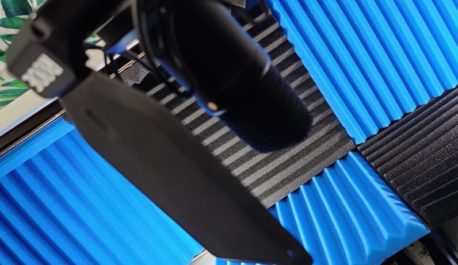
Please Prevent Plosives
Back at it again with a post on Audio Engineering.
Plosives, let’s talk about what they are, the importance of preventing them, and perhaps more importantly how to address them when they occur.
Plosives pose particular problems for the listener.
Plosives are a speech sound that occur when a blast of air leaves your mouth. Think of it like a shockwave of an explosion. Get it, ex-PLO-sion, PLO-sive. Most commonly these occur when you say a B, P, or T sound. D, F, and W less commonly, but can also create this issue depending on your particular pronounciation and how loud you are speaking.
At it’s simplest (not addressing Dynamic, Condenser, or other physical microphone configurations) microphones have a very sensitive diaphragm which picks up the vibrations created by your vocal chords. As your vocal chords move, they cause vibrations in the air exiting your mouth and nose, those vibrations are movements of air. The air movements are felt by the diaphragm of the microphone and magic happens inside which turns it into the sounds you hear coming out of the speakers.
A plosive occurs when the shockwave of your breath overpowers and overrides the gentler sound vibrations. It’s pretty easy to see in the waveform of an audio recording. Looks basically like this:
The exact shape may vary slightly, but can be easily picked out along the wave form.
Any time you have one of these, even though the volume may not be all that loud, it makes the speakers do the same movement. A big movement of the speaker, translating to a big movement of air, which results in a pressure wave hitting your ear drums that is not particularly comfortable no matter how low the volume.
This leads us to the importance of avoiding plosives in your recording. If you’ve ever been at a concert where there is a really heavy bass sound and you get the sensation that your chest is pounding in rhythm with the music this is a good example of the effect a plosive has on your ear drum. It isn’t perceived as a sound so much as a sensation of your ear drum being poked. As you can imagine, this isn’t pleasant. Imagine the sensation of someone tapping your head repeatedly. Now imagine instead of tapping on you head, they are tapping on your brain. Repeated plosives will feel about how your imagine that to be. Not great is it? So avoiding plosives through microphone placement, vocal techniques and the like is crucial to creating a pleasant sound.
In a particularly energetic performance plosives can get even the best of us. Have no fear however, it is possible to address the issue after the fact. Here is where working with someone who understands how to interpret wave form, how to balance tonal qualities, and how to do a bit of mastering can make the difference between a good recording and an annoying one.
Like many of you, I often search for tutorials online. For cooking, music creation, how to clip a cats claws, you name it. Sometimes I will find a really informative video but it is laden with plosives and I just can’t listen through the whole thing. We all love boomy voices like James Earl Jones or Morgan freeman. They can be soothing and inspiring. However, that same silky smooth voice can turn grating or fatiguing if it isn’t properly balanced or contains loads of plosives.
Now imagine instead of tapping on you head, they are tapping on your brain.
Do yourself a favor and reach out to experienced audio talent. Sometimes it’s as simple as adjusting how you use the microphone. If you already have the audio and don’t want to re-record ask for help in editing out the harshest moments of the plosives. Good audio vs great audio may not be so perceptible on some media, and perhaps it doesn’t affect your view count too significantly, but the difference between good and bad can have a catastrophic effect on retention of your viewership.
Friends don’t let friends leave plosives in their audio.
Need help and not sure where to turn?
-Let’s Talk
“The difference between good and bad can have a catastrophic effect on retention of your viewership.”